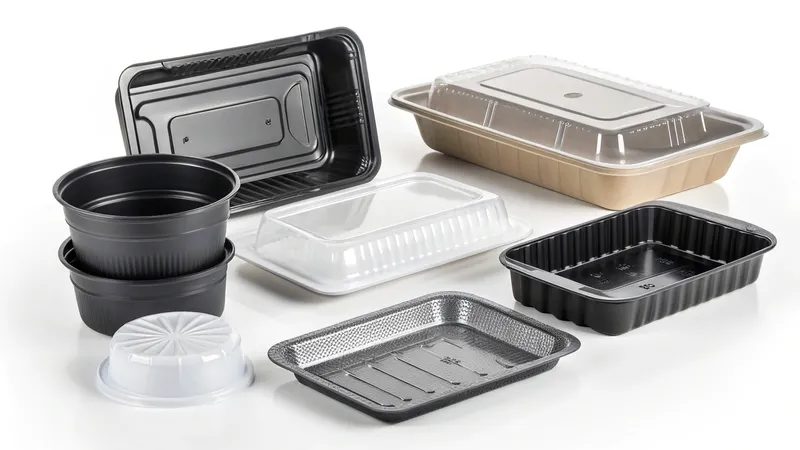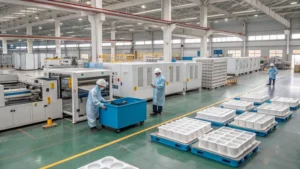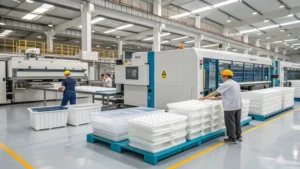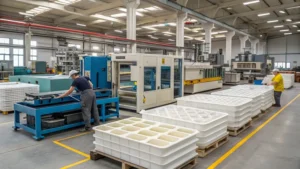
Plastic vacuum forming is a versatile and cost-effective manufacturing process widely adopted in Malaysia’s thriving plastic industry. This technique heats a plastic sheet until it becomes pliable, then uses vacuum pressure1 to mold it into a specific shape. From packaging to automotive components, vacuum forming is essential for producing diverse products efficiently. In this blog post, we’ll highlight the top 10 plastic vacuum forming2 factories in Malaysia, explore the process in depth, and provide practical insights to guide your manufacturing decisions.
Vacuum forming creates custom plastic shapes3 by heating sheets and using vacuum pressure to mold them, ideal for packaging, automotive, and medical applications due to its cost-effectiveness and adaptability.
Understanding vacuum forming and its applications can help you leverage its benefits for your industry. Let’s dive into Malaysia’s leading factories, the process details, and key considerations for successful implementation.
Vacuum forming is cost-effective for low-to-medium volume production.True
It requires less expensive tooling compared to injection molding, making it ideal for smaller production runs.
Vacuum forming can produce parts with high precision.False
While it offers good detail, it doesn’t match the precision of injection molding for complex geometries.
- 1. What are the Top 10 Plastic Vacuum Forming Factories in Malaysia?
- 2. What is Plastic Vacuum Forming?
- 3. What are the Typical Applications of Vacuum Forming?
- 4. What are the Pros and Cons of Vacuum Forming Compared to Other Technologies?
- 5. What is the Full Workflow of the Vacuum Forming Process?
- 6. What are the Key Design Considerations for Vacuum Forming?
- 7. What are the Related Technologies to Vacuum Forming?
- 8. 결론
What are the Top 10 Plastic Vacuum Forming Factories in Malaysia?
Malaysia’s plastic manufacturing sector boasts several standout vacuum forming factories, each excelling in areas like packaging, automotive, and innovative hybrid technologies.

The top 10 plastic vacuum forming factories in Malaysia include Lee Soon Seng Plastic Industries, Integrated Formway, and MY3D World, renowned for their expertise in food packaging, automotive components, and 3D printing integration.
| Rank | Company Name | Location | Specialization | Website/Notes |
|---|---|---|---|---|
| 1 | Lee Soon Seng Plastic Industries Sdn Bhd (Benxon) | Kulai, Johor | Food packaging, over 4,000 products | benxonpack.com |
| 2 | Integrated Formway Sdn Bhd | Balakong, Selangor | Trays, blister packaging, ISO 9001:2015 certified | ifway.com.my |
| 3 | MY3D World Sdn Bhd | Puchong, Selangor | Vacuum forming, 3D printing services | my3dworld.n.my |
| 4 | Multiplex Packaging Sdn. Bhd. | Malaysia | Food and beverage packaging, cups, trays | mtppackaging.my |
| 5 | Exaltech Sdn. Bhd. | Malaysia | Automotive, food, beverage, high-quality forming | No URL, industry listing |
| 6 | Advance Vacuum Forming Sdn Bhd | Malaysia | Vacuum forming services | No URL, listed on supplierss.com |
| 7 | Multi Packaging Sdn. Bhd. | Malaysia | Packaging solutions, includes vacuum forming | No URL, listed on supplierss.com |
| 8 | PKG Plastics Technology Sdn Bhd | Malaysia | Assumed vacuum forming, industry listing | No URL, listed on suppliersof.com |
| 9 | Parade Manufacturing Sdn Bhd | Malaysia | Likely vacuum forming manufacturer | No URL, listed on suppliersof.com |
| 10 | Wah Ngai Industries (M) Sdn Bhd | Malaysia | Plastic manufacturing, includes vacuum forming | No URL, listed on suppliersof.com |
주요 인사이트
-
Lee Soon Seng Plastic Industries (Benxon) dominates food packaging with an extensive product range.
-
Integrated Formway ensures quality with ISO certification, specializing in trays and blisters.
-
MY3D World blends vacuum forming with 3D printing, offering cutting-edge solutions.
Malaysia has a diverse range of vacuum forming factories.True
Factories cater to various sectors, from packaging to automotive, meeting diverse industry needs.
All top factories have publicly accessible websites.False
Several are listed in industry directories but lack official websites.
What is Plastic Vacuum Forming?
Plastic vacuum forming is a manufacturing process that shapes 열가소성 시트4 into custom forms using heat and vacuum pressure, prized for its efficiency and versatility.
Plastic vacuum forming, or vacuum thermoforming5, heats a plastic sheet, stretches it over a mold, and applies vacuum pressure to shape it, perfect for packaging, automotive, and medical uses.

Definitions and Terminology
Also known as vacuum thermoforming, this process heats a thermoplastic sheet to its forming temperature (typically 150–200°C) and uses a vacuum to mold it against a form. It’s often simply called "vacuum forming" or "thermoforming," with the core principle being the use of vacuum pressure to achieve the shape.
분류
-
프로세스 관점:
- Male (Positive) Molding: Sheet stretches over a convex mold, shaping inner dimensions—common for packaging.
- Female (Negative) Molding: Sheet pulls into a concave mold, shaping outer dimensions—ideal for deeper parts.
-
재료 관점:
- Includes ABS (impact-resistant), HIPS (cost-effective), PVC (rigid), PETG (transparent), and acrylic (clear).

- 애플리케이션 관점:
- 패키징: Blister packs, trays.
- 자동차: Dashboards, trim.
- 의료: Device housings, trays.
- 소비재: Toys, casings.
Vacuum forming is primarily used for packaging.False
It’s also widely applied in automotive, medical, and consumer goods industries.
Vacuum forming can use a variety of thermoplastic materials.True
Materials like ABS, HIPS, PVC, and PETG offer unique properties for different uses.
What are the Typical Applications of Vacuum Forming?
Vacuum forming shines in producing large, lightweight, and affordable plastic parts across various sectors.
Vacuum forming excels in 포장6, 자동차7, medical, and consumer goods, creating trays, enclosures, and components with its versatility and low tooling costs.

포장 산업
Perfect for blister packs, clamshells, and food trays, vacuum forming excels due to its ability to produce thin-walled, large parts efficiently.
Automotive Sector
Used for prototyping and crafting interior parts like dashboards and door panels, where size and design flexibility matter.

Medical Field
Produces device housings, surgical trays, and packaging, often with materials like PETG for clarity and regulatory compliance.
소비자 제품
Shapes toys, electronics enclosures, and household items, balancing lightweight design with visual appeal.
Vacuum forming is only suitable for small parts.False
It’s great for large parts like dashboards and trays.
Vacuum forming is cost-effective for prototyping.True
Low tooling costs make it ideal for prototypes and small runs.
What are the Pros and Cons of Vacuum Forming Compared to Other Technologies?
Vacuum forming stands out with unique strengths and trade-offs when pitted against processes like injection molding and blow molding.
Vacuum forming offers 툴링 비용 절감8 and faster setup than injection molding but less precision; it’s better for large, thin-walled parts than blow molding’s hollow structures.

사출 성형과의 비교
-
장점: Cheaper tooling (aluminum vs. steel), quicker setup9, suits large parts and low-to-medium volumes (100–10,000 units).
-
단점: Lower accuracy, struggles with complex undercuts or fine details, not ideal for high-volume runs.
블로우 성형과 비교
- 장점: Excels at non-hollow, thin-walled parts10 with complex shapes; no preforms needed.

- 단점: Can’t create fully enclosed hollow parts (e.g., bottles) without extra steps; less versatile for flat parts.
Vacuum forming is more cost-effective than injection molding for large parts.True
Lower tooling costs make it economical for large parts in smaller quantities.
진공 성형은 사출 성형과 동일한 수준의 디테일을 구현할 수 있습니다.False
Injection molding provides higher precision for intricate designs.
What is the Full Workflow of the Vacuum Forming Process?
The vacuum forming process is a structured sequence of steps, each vital for quality outcomes.
The vacuum forming process includes mold creation, material selection, heating, forming, cooling, and finishing, with temperature and vacuum pressure as key factors.

단계별 분석
-
Design and Mold Creation: Design via CAD; craft molds from aluminum or wood with vent holes and 3° draft angles.
-
재료 선택: Pick a thermoplastic (e.g., ABS, HIPS) based on thickness (0.5–10mm) and properties.
-
난방: Heat the sheet to forming temperature (e.g., 150–200°C for ABS) using ovens or heaters.
-
형성: Apply vacuum (28–30 inches Hg) to shape the sheet over the mold; pre-stretch for deep draws.

-
냉각: Cool the part with fans or air for 10–30 seconds to set the shape.
-
트리밍 및 마무리: Trim excess with CNC or manual tools; add painting or assembly as needed.
재료 호환성
- ABS: Impact-resistant, forms at 150–200°C, great for automotive.

-
HIPS: Affordable, forms at 120–150°C, used in packaging.
-
PVC: Rigid, forms at 140–180°C, ideal for blisters.
-
PETG: Clear, FDA-approved, forms at 160–200°C, suits medical uses.
Material thickness affects the forming process.True
Thicker sheets allow deeper draws but need more heat.
All thermoplastics can be used in vacuum forming.False
Only reshapeable thermoplastics work; thermosets don’t.
What are the Key Design Considerations for Vacuum Forming?
Effective vacuum forming design hinges on specific factors to ensure quality and manufacturability.
Key design considerations include draft angles, material thickness, undercuts, and vent holes, impacting part removal, strength, and finish.

디자인 체크리스트
-
초안 각도: Minimum 3° on vertical surfaces for easy removal.
-
Material Thickness: Thicker (6–10mm) for complex shapes; thinner (0.5–2mm) for packaging.
-
언더컷: Minimize deep undercuts; use split molds if needed.
-
Vent Holes: Add sufficient holes to avoid air traps.
-
트림 라인: Plan clear lines for post-forming trimming.
프로세스 선택 의사 결정
Vacuum forming suits:
- Low-to-medium volumes (100–10,000 parts).

-
Large, thin-walled parts.
-
Cost-sensitive projects needing affordable tooling.
의사 결정 트리:
-
Step 1: Large, thin-walled part? → Yes → Consider vacuum forming.
-
Step 2: High-volume needed? → No → Vacuum forming fits.
-
Step 3: Complex undercuts? → No → Vacuum forming works.
-
Step 4: Cost a priority? → Yes → Vacuum forming is ideal.
진공 성형에서 구배 각도는 선택 사항입니다.False
They’re critical for part removal and preventing damage.
Vacuum forming is suitable for high-volume production.False
It’s best for low-to-medium volumes; injection molding excels in high volumes.
What are the Related Technologies to Vacuum Forming?
Vacuum forming integrates with a network of technologies that enhance its production capabilities.
Related technologies include plastic extrusion for sheet production, CNC machining for trimming, and blow molding for hollow parts, each supporting vacuum forming.

업스트림 기술
-
플라스틱 압출: Makes the thermoplastic sheets used in vacuum forming.
-
3D 프린팅: Crafts rapid mold prototypes.
다운스트림 기술
-
CNC 가공: Trims and finishes parts precisely.
-
사출 성형: Handles high-volume, high-precision production.
Complementary Technologies
-
블로우 성형: Creates hollow parts like bottles.
-
회전 성형: Forms large, uniform hollow items.
Vacuum forming can be combined with 3D printing for mold creation.True
3D printing enables fast, affordable mold prototyping.
Vacuum forming is a standalone process with no related technologies.False
It works with extrusion, machining, and other molding methods.
결론
Plastic vacuum forming is a vital process in Malaysia’s plastic industry, offering an economical and flexible solution for diverse products. The top 10 factories, such as Lee Soon Seng Plastic Industries and Integrated Formway, showcase Malaysia’s prowess in this field. By grasping the process, applications, and design essentials, you can optimize your manufacturing choices. Check out these factories and consider vacuum forming for your next project to tap into its cost-effective potential.
-
Learn about the role of vacuum pressure in shaping plastic, which is crucial for achieving high-quality products. ↩
-
Explore the advantages of plastic vacuum forming to understand its impact on manufacturing efficiency and cost savings. ↩
-
Discover the various industries that utilize custom plastic shapes, enhancing your knowledge of market applications. ↩
-
Learn about thermoplastic sheets and their significance in manufacturing processes, including vacuum forming. ↩
-
Explore this link to understand the detailed applications and benefits of vacuum thermoforming in various industries. ↩
-
Discover the innovative applications of vacuum forming in packaging, including its advantages for creating efficient and cost-effective solutions. ↩
-
Learn about the significance of vacuum forming in automotive design and production, particularly for creating lightweight and customizable parts. ↩
-
Understanding the advantages of lower tooling costs can help you make informed decisions in manufacturing. ↩
-
Exploring quicker setup benefits can enhance your knowledge of efficient manufacturing practices. ↩
-
Learning about thin-walled parts can inspire innovative design solutions and cost savings in production. ↩








